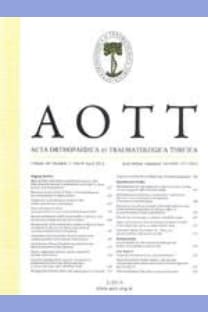A new surgical technique to facilitate osteochondral autograft transfer in osteochondral defects of the capitellum: a case report
Ergen, Manyetik rezonans anjiyografi, Tedavi sonucu, Erkek, Kıkırdak, eklem, Dirsek eklemi, Osteokondritis dissekans, Nakil, otolog
Kapitellum osteokondritis dissekansında otolog osteokondral greft naklini kolaylaştıran yeni bir cerrahi teknik: Olgu sunumu
Adolescent, Magnetic Resonance Angiography, Treatment Outcome, Male, Cartilage, Articular, Elbow Joint, Osteochondritis Dissecans, Transplantation, Autologous,
___
- 1. Wood VE. Different manifestations of hyperphalangism. J Hand Surg [Am] 1988;13:883-7.
- 2. Rowe-Jones JM, Moss AL, Patton MA. Brachydactyly type C associated with shortening of the hallux. J Med Genet 1992;29:346-8.
- 3. Haws DV. Inherited brachydactyly and hypoplasia of the bones of the extremities. Ann Hum Genet 1963;26:201-12.
- 4. Günal I, Durak T, Öztuna V, Seber S. Various manifestations of hyperphalangism. J Hand Surg [Br] 1996;21: 405-7.
- 5. Almasi A, Solgaard S. Polyphalangism-a rare anomaly. [Article in Danish] Ugeskr Laeger 2006;168:2472-3.
- 6. Wood VE. Hyperphalangism. In: Green DP, Hotchkiss RN, Pederson WC, editors. Green’s operative hand surgery. Vol. 1, 4th ed. New York: Churchill Livingstone; 1998. p. 501-10.
- ISSN: 1017-995X
- Yayın Aralığı: 6
- Başlangıç: 2015
- Yayıncı: Türk Ortopedi ve Travmatoloji Derneği
Fikri Erkal BİLEN, Mehmet KOCAOĞLU, Levent ERALP
Successful replantation in ten-digit amputation
Ümit KANTARCI, Selim ÇEPEL, Halil BULDU
Hyperphalangism accompanied by brachydactyly of the feet: a case report
The results of surgical repair of sciatic nerve injuries
Atakan AYDIN, Türker ÖZKAN, Hasan Utkan AYDIN, Murat TOPALAN, Metin ERER, Safiye ÖZKAN, Hoşbay Zeynep YILDIRIM
Merter YALÇINKAYA, Ahmet DOĞAN, Ufuk ÖZKAYA, SAMİ SÖKÜCÜ, Onat ÜZÜMCÜGİL, Yavuz KABUKÇUOĞLU
Bora BOSTAN, Ufuk ŞEN, TANER GÜNEŞ, Seyyid Ahmet ŞAHİN, Cengiz ŞEN, MEHMET ERDEM, ÜNAL ERKORKMAZ
Early results of total knee arthroplasty performed through the midvastus approach
Cemil ERTÜRK, MEHMET AKİF ALTAY, SERKAN SİPAHİOĞLU, SİNAN ZEHİR, Hüseyin AKŞAR
Modified Fulkerson osteotomy in recurrent patellofemoral dislocations
Umut AKGÜN, Rüştü NURAN, Mustafa KARAHAN
Kerem BİLSEL, MEHMET SELAHATTİN DEMİRHAN, Ata Can ATALAR, Semih AKKAYA
